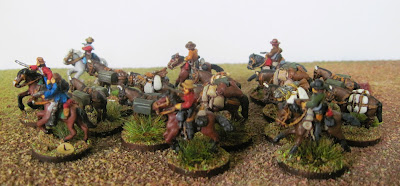Here are some suggestions to enable you to use Barry Hilton’s
Republic to Empire to game the battles of the Anglo-Sikh Wars. These deal with Sikh Gorchurra, Akali,
Matchlock men, Artillery, British infantry fire-power and more.
You can find the rationale for much that follows in my various articles on the Anglo-Sikh Wars posted on this blog. Should Republic to Empire not be your cup of tea I hope you will still find the following of interest.
Above, my final unit of Khalsa Regulars. The following pic's are the newest and last ones of my Anglo-Sikh Wars Collection. Yes, it is really finished-apart from some artillery elephants.
Traitor Generals
Should the Sikh General prove to be a traitor double cost
of all MPs for Sikh Brigade Actions.
Roll a D6 on a score of 1 the General is a traitor and is removed from
the Battle Field. I see a possible application here for India 1857 in respect of Sepoy units without a General Officer Commanding.
Cold Steel Assaults
Senior British Commanders liked to assault with cold
steel. Roll a D6, on a score of 6 two
British Brigades enter the battle unloaded.
On a score of 5, one British Brigade does so. Such brigades can only fire after their first attempted charge home.
Cavalry v Cavalry Broad Strokes
British and Indian regular cavalry fight Sikh regular
cavalry as written in Republic to Empire.
Gorchurra and Indian irregular cavalry fight each other as
written in Republic to Empire.
The Gorchurra
Gorchurra move as light cavalry in column of march and
fight in column of squadrons.
Gorchurra are never disordered by melee.
Before melee they shoot, throw a D3 the result is the
number of shooting dice.
Range is point blank.
Any casualties caused make opponents do an officer casualty
check.
Armoured Gorchurra count as cuirassiers in melee.
British and Indian regular cavalry will pass through the Gorchurra
post melee regardless of the combat result.
Gorchurra may then turn to face at a cost of 1mp.
Add Resolve Check minus to Gorchurra if under artillery
fire.
Indian Irregular Cavalry
Indian Irregular Cavalry move as light cavalry in column of
march and fight in column of squadrons.
Some Indian Irregular Cavalry shoot, if so equipped, throw a D3 the result
is the number of shooting dice. Measure for range.
Indian Irregular Cavalry are never disordered by melee.
Add Resolve Check minus to Indian Irregular Cavalry if under artillery
fire.
British regular cavalry
British regular cavalry, except charging Lancers, fight as disordered against
Gorchurra.
Post melee British regular cavalry measure their outcome
move from the point that they passed through the Gorchurra. That is, immediately behind the Gorchurra and
facing the same direction of their initial charge.
Indian regular cavalry
Indian regular cavalry count, -2 on the Resolve Check
Procedure if ordered to charge Gorchurra.
If an Indian regular cavalry unit refuses to charge, but holds position, they may shoot, throw a D3 the result is the number of shooting dice. Measure for range.
Indian regular cavalry, except charging Lancers, fight as disordered against
Gorchurra.
Artillery
The Sikh regular artillery outperformed its British counter
parts. Rate Sikh regular artillery as
veteran. British as trained. There is good evidence from 1857 that Sepoy Artillery outshot and were more accurate than their British equivalents. So perhaps British Native Artillery should be rated as the Sikh artillery. Sikh Irregular artillery as trained or recruit.
Matchlock Men
Sikh irregular foot using matchlocks or jezails shoot as Recruits. This reflects the slower loading and various
ranges of their firearms.
In combat they gain the “Pike” bonus and, as they are never
disordered by melee, keep it.
British Regular Infantry
British infantry fire power was impressive.
Conditions in India often were not ideal.
The heat was hard upon the British infantry. Forced
marching doubly so.
Sometimes their Generals threw them into combat without
adequate rest and refreshment.
After deployment throw a D6.
On a score of 1,2,3 the British infantry gain a D3 result
of extra shooting dice as written in Republic to Empire.
On a score of 4,5,6 they do not.
I'm not applying this to Sepoy units.
Khalsa Infantry and Artillery
Khalsa Infantry and Artillery gain a D3 result of
additional dice in the first round of melee.
Akali
Akali warriors should be Guard or Veteran.
They may shoot, throw a D3, the result is the number of
shooting dice available. Measure for range.
In combat they gain the “Pike” bonus and, as they are never
disordered by melee, keep it.
Where next on this? We are going to see both armies and then a try out game.






















































